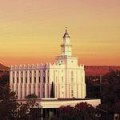 Mormon temples are designed to be a place set apart from the world, even more so than chapels. The atmosphere of the Mormon temple is to be light and peaceful, a refuge from the world and a place where the Spirit of God can have great influence. For these reasons, only Mormons who have prepared themselves through faith and repentance in Jesus Christ’s name can enter the temple. The Mormon Temple is the House of God, and a Holy Place where people learn about God and his plan for all mankind and where they participate in sacred temple ceremonies which help prepare them for eternal life.
Mormon temples are designed to be a place set apart from the world, even more so than chapels. The atmosphere of the Mormon temple is to be light and peaceful, a refuge from the world and a place where the Spirit of God can have great influence. For these reasons, only Mormons who have prepared themselves through faith and repentance in Jesus Christ’s name can enter the temple. The Mormon Temple is the House of God, and a Holy Place where people learn about God and his plan for all mankind and where they participate in sacred temple ceremonies which help prepare them for eternal life.
God has revealed to modern Mormon prophets like Joseph Smith that certain ceremonies can only be performed in temples. Mormons called these sacred temple ceremonies, ordinances. Ordinances are symbolic ceremonies which teach truths about God through which a person can enter into powerful covenants with God.
Inside the Mormon temple there are primarily two ordinances performed for the members of the Mormon Church. The first of these Mormon temple ceremonies is known as the temple endowment, and the second as the sealing ordinance, key to celestial (or eternal) marriage. The first ordinance is designed for individuals, and the second is designed to create eternal families. These ordinances are very sacred and holy, so faithful Mormons don’t discuss their details outside of the temple, even with each other. While no doctrine is taught in Mormon temples that is not taught publicly, the ceremonies themselves are viewed as very sacred and very personal.
Mormons who have participated in these sacred Mormon temple ceremonies make covenants with God. As a reminder of the covenants they have made, faithful Mormons wear special garments at all times under their clothes. These sacred garments, which some people outside of the Mormon Church refer to as Mormon underwear, are an outward expression and symbol of the covenants Mormons have made with God and of the promises God has made to man.
Not only are the temples provided so that Mormon temple ceremonies can be done for the living, but Mormon temple ordinances can also be done for those who are dead. Mormons believe that earthly ordinances must be performed, even for those who are no longer capable of performing those ordinances for themselves. There are many people who have lived on this earth without ever hearing the name of Jesus Christ, or coming to understand the sacrifice He made for them. Would God be just in consigning them to hell for not believing in someone of whom they had never heard?
 All of the ordinances offered in the Mormon temple for living members of the Mormon Church are also performed by proxy for those who have passed on. Temple marriage, sealings, and endowments are performed with someone symbolically standing in for the person who is deceased. Baptisms are also performed by proxy for these people who have passed on. Baptisms for the dead, as they are called, are perhaps the most widely known Mormon temple ceremony.
All of the ordinances offered in the Mormon temple for living members of the Mormon Church are also performed by proxy for those who have passed on. Temple marriage, sealings, and endowments are performed with someone symbolically standing in for the person who is deceased. Baptisms are also performed by proxy for these people who have passed on. Baptisms for the dead, as they are called, are perhaps the most widely known Mormon temple ceremony.
Because we have no way of knowing who will or will not accept the gospel of Jesus Christ, temple ordinances are performed for everyone who has passed on. To have a family member who has passed on baptized by proxy does not commit that deceased person to accept a “Mormon baptism.” Instead, it merely gives that person the opportunity to accept or reject the ordinance as he or she chooses.
In order to discover those who died without having had a chance to accept baptism in the name of Jesus Christ through His authorized servants, Mormons believe that genealogy and family history research are important works. Mormons have amassed the world’s largest genealogical index, and it is available online to help everyone search for their deceased ancestors. Mormons believe that the interest people have for searching for their lost ancestors is a work inspired by God to bless all of His children. To begin searching for your ancestors, see Familysearch.com.
Twitter •


 Watch a video about the restoration of the gospel on lds.org
Watch a video about the restoration of the gospel on lds.org
Trackbacks/Pingbacks